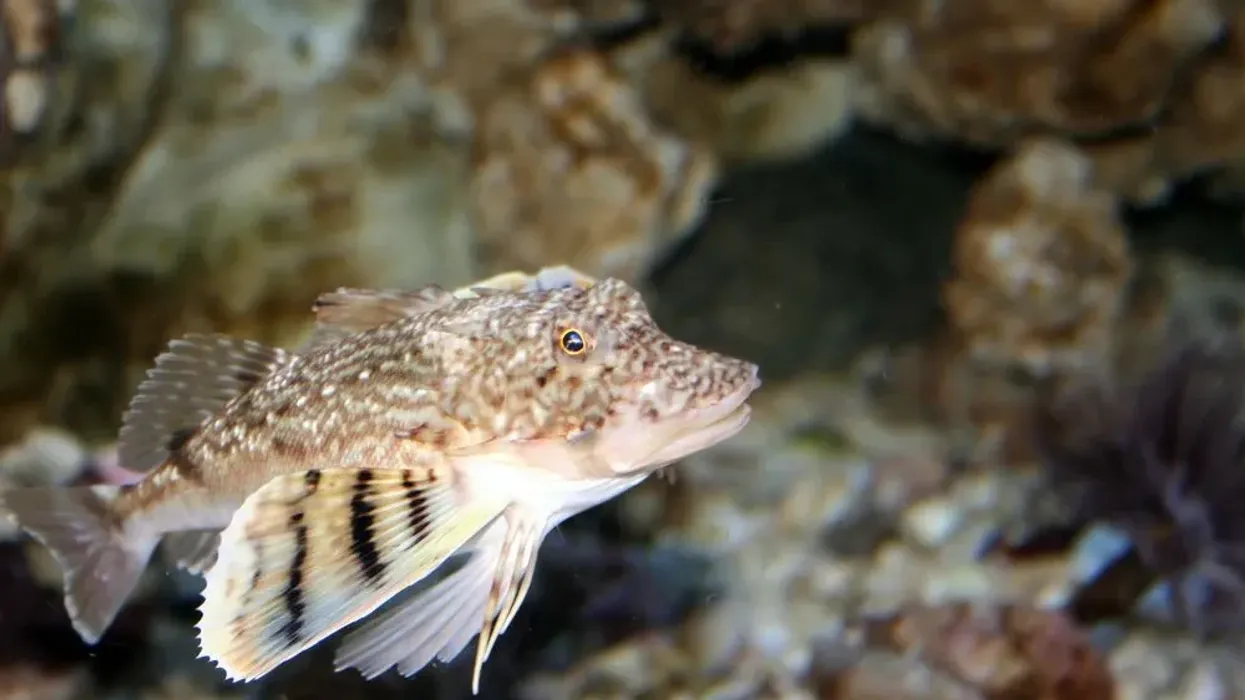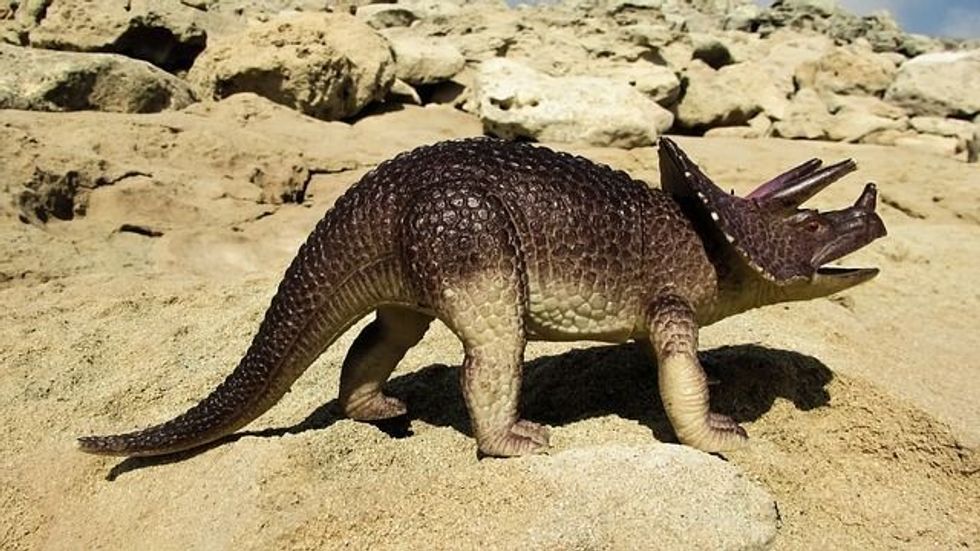The northern searobin is a species of fish native to the continent of North America, mainly the eastern coast of the United States, from New York to the Cape Hatteras, and from the Gulf of Mexico to Nova Scotia. It is also known as gurnard or the common sea robin.
The 'searobin' name partially comes from the wing-like pectoral fins that make it look like a bird.
The northern searobin habitat is the sandy bottoms of the continental shelf of the continent. This bony fish is also known to make a croaking call using its swim bladder and has a black spot on the initial dorsal fin.
The northern searobin reproduces via external fertilization and is known to give out a staccato-like call in the mating season.
This species is often caught accidentally by recreational and commercial fishermen. Its eggs are sometimes used as a caviar substitute and the bony fish itself is eaten with food like soups and stews.
For more relatable content, check out these Caribbean reef shark facts and thresher shark facts for kids.
Northern Searobin Interesting Facts
What type of animal is a northern searobin?
The northern searobin (Prionotus carolinus) is a fish.
What class of animal does a northern searobin belong to?
The northern searobin (Prionotus carolinus) belongs to the Actinopterygii (ray-finned fish) class of animals.
How many northern searobins are there in the world?
The exact number of northern sea-robins in the world is unknown since it is a common catch in the fishing industry, recreational and commercial.
Where does a northern searobin live?
The northern searobin (Prionotus carolinus) is found along the length of the sandy continental shelf of the North American continent, mainly the eastern coast of the USA from New York to North Carolina's Cape Hatteras, and Nova Scotia to the Gulf of Mexico. It is found in the Atlantic Ocean.
What is a northern searobin's habitat?
Northern sea-robins favor sandy bottoms along the continental shelf, close to every coast from Nova Scotia to the Gulf of Mexico, and in estuaries. These marine animals are also found closer to the ocean surface in their range sometimes.
They live in water temperatures of 40-64.4 °F (4.4-18 °C). The salinity of waters near the coast in their habitat range is about 20%.
Who does a northern searobin live with?
It is unclear whether the northern searobin (Prionotus carolinus) species lives in schools, but it is most probably a solitary fish.
How long does a northern searobin live?
It is unclear how long northern searobin fishes live, but their generation time length is 3.7 years, and the time length required for population doubling is 1.4-4.4 years.
How do they reproduce?
Northern searobin fishes reproduce by laying eggs and external fertilization. Females lay eggs on sandy areas which are then fertilized by males.
Northern searobin fishes attain maturity at two years of age. These marine animals are ripe during the months of July-September. A staccato call is produced by northern searobins during mating season which differs from the grunts they make.
The testes are white, long, and clear. The eggs look invisible when laid and the ovaries are orange or yellow. As the ovaries ripen, the eggs become visible. They are the shape of a triangle.
The size of the eggs is 0.008-0.04 in (0.2-1 mm). Eggs do fine in waters up to 71.6 °F (22 °C) and they hatch in just 60 hours. The parents do not show any parental care for the young.
What is their conservation status?
The conservation status of northern searobin species according to the International Union for Conservation of Nature is Least Concern.
Northern Searobin Fun Facts
What do northern searobins look like?
Northern searobins are round in the front and get thinner as they go back. Northern searobins are red or gray on the top and pale on the bottom.
The bony head is large and has several spines and ridges. Some of these spines and ridges disappear with age. The chin is black and pectoral fins sometimes look like wings.
The fins are a reddish-brown color, almost looking black on top and whitish-gray at the bottom. The pelvic fins of northern searobins are white. The first dorsal fin has a black spot right between the fourth and fifth spines.
The soft dorsal fins and anal fins are long and the spiny dorsal fin is in the shape of a triangle. It also has a swim bladder that makes a croaking call.

*Please note that this is an image of a bandtail searobin, not a northern searobin. If you have an image of a northern searobin, please let us know at hello@kidadl.com.
How cute are they?
Northern searobins aren't very cute animals. These marine animals aren't a very pleasing color and have bulgy eyes. Their bony heads look too big for their bodies. The fishermen call it a 'trash fish'.
They are small fish with a black spot on the initial dorsal fin. A redeeming feature is the wing-like pectoral fins. The pectoral fins make them look like robins of the seas hence the name 'searobins'.
How do they communicate?
A northern searobin communicates via different calls. It makes a croaking call, much like a frog's, using its swim bladder. They also make staccato calls during mating season. They usually make grunt-like sounds. Since they are fish, northern searobins also probably use motion and gesture.
How big is a northern searobin?
On average, the typical northern searobin size is 17 in (43 cm) long, which makes it 12-17 times bigger than the black phantom tetra.
How fast can a northern searobin swim?
It is unclear exactly how fast a northern sea-robin can swim, but comparing it with other ray-finned fish of a similar length, they may swim at speeds close to 3.7 mph (6 kph).
How much does a northern searobin weigh?
A northern sea-robin usually weighs less than 2.2 lb (1 kg).
What are the male and female names of the species?
The males and females of the northern sea-robin species do not have specific names.
What would you call a baby northern searobin?
A baby northern sea-robin would be called a fry or a juvenile.
What do they eat?
Northern searobins are not picky about food. These marine animals are carnivores who eat herring, shrimp, seaweed, amphipoda, cumacean, gammarus, crabs. They also use squid, segmented worms, bivalve mollusks, copepods, other fish & their eggs as food.
Are they dangerous?
Northern searobins are largely harmless. These marine animals have a very mild poison in the dorsal fins and the gill plates, specifically the sharp spines. If stung, some pain is experienced for few days.
Would they make a good pet?
Northern searobins are not popular as pets. They are instead used as pet food, in fertilizer, and as bait for marine species like lobsters.
Did you know...
Sea robins are edible, they have a subtle flavor, similar to flounders, whitings, and flukes. They are incorporated into soups and stews. These marine animals are sometimes difficult to clean because of their bony fins. Their eggs are sometimes used as a caviar substitute.
Sea robins is another name for the fish in the Triglidae family. This family contains nine different genera of bony fish found near the coast in the Atlantic, Pacific, and Indian oceans over a wide range of habitats.
Sea robins are carnivores and eat a range of food like herring, seaweed, shrimp, squid, worms, and mollusks.
Sea robins grow to be anywhere between 4.7-17 in (12-43 cm).
Is the northern searobin poisonous?
The northern sea-robin is mildly poisonous. These marine animals carry a mild poison in their sharp spines, but it is only capable of causing some pain for a couple of days.
Are sea robins endangered?
No, searobins are not endangered. These marine animals have abundant populations in their habitat range and most are classified as a species of Least Concern by the IUCN.
Here at Kidadl, we have carefully created lots of interesting family-friendly animal facts for everyone to discover! For more relatable content, check out these catfish surprising facts and parrotfish fun facts pages.
You can even occupy yourself at home by coloring in one of our free printable marine angelfish coloring pages.








